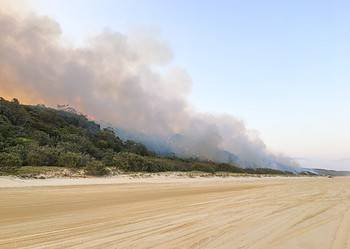Sand plays an important role in the natural world, providing valuable environmental services and maintaining biodiversity. It’s also an important commodity for human society, being used in everything from cement to paint. However, its extraction, sourcing, use, and management remain largely ungoverned, leading to overlooked environmental and social problems, a new report has found. Simply put, some parts of the world are running out of sand.

The UN Environment Program (UNEP) published a new report looking at the role of sand around the world amid a surge in demand because of urbanization and population growth. Sand is the most exploited natural resource in the world and we are consuming it faster than it can be replaced by geological processes, UNEP said.
“We now find ourselves in the position where the needs and expectations of our societies cannot be met without improved governance of sand resources,” Sheila Aggarwal-Khan, the director of the Economy Division at UNEP said in the report’s foreword. “If we act now, it is still possible to avoid a sand crisis.”
A resource under stress
Sand, gravel, crushed stone, and aggregates are the second most exploited natural resource in the world after water, and their use has tripled in the last two decades to reach an estimated 40-50 billion metric tons per year, UNEP said. Sand is used as a raw material for concrete, asphalt, and glass, as well as for flood protection in coastal areas.
Sand supply is often perceived to be unlimited, but that’s not really the case. Naturally occurring sand is finite and non-renewable in economic timescales, which means its uses and their inherent trade-offs need to be examined closely and re-evaluated, UNEP said. We are not even considering the cultural importance of sand in many places, and its importance to ecosystems is also often left in the background.
Sand extraction is done in different ways, from the dredging of lakes and rivers to various kinds of land mining and the crushing of rock. This leads to significant environmental impacts, such as river erosion, air pollution, land-use changes and shrinking deltas, which can trigger or amplify socio-economic conflicts.
UNEP’s Pascal Peduzzi, who coordinated the report, told journalists some of the impacts are already being felt. In the Mekong River, for example, sand extraction is causing the delta to sink, while in the Sri Lankan river sand removal has reversed the water flow – meaning ocean water is heading inland and bringing crocodiles with it.
Studies have suggested about 1,000 threatened species of animals and plants are affected by sand and gravel extraction, which extends to 24,000 species overall. However, the situation could be much more severe, UNEP said, especially considering the appetite for sand is expected to grow considerably over the coming years.
Among its recommendations, UNEP called for reducing demand by reusing sand from recycled materials, such as concrete and mining tailing, instead of using naturally occurring sand. The report also suggested implementing a ban on beach extraction and creating a global standard for marine dredging that can affect ocean biodiversity.
Recognizing and formalizing sand as a strategic resource at all levels of government and society is also a crucial step in the transition towards sustainable sand resource governance and management, UNEP said, asking for the participation of all people in decision-making processes in order to avoid pitfalls of one-size-fits-all solutions.






